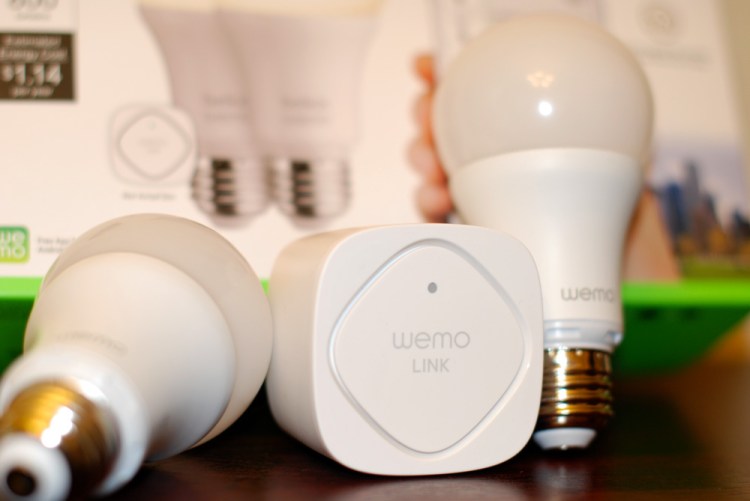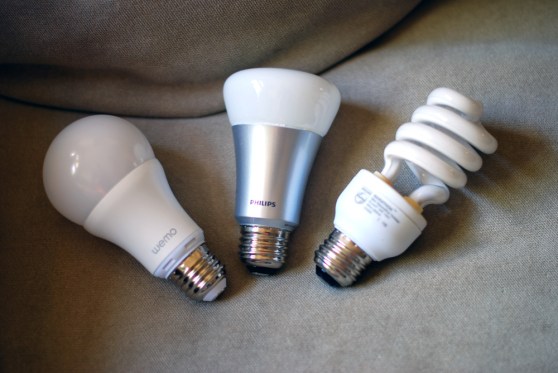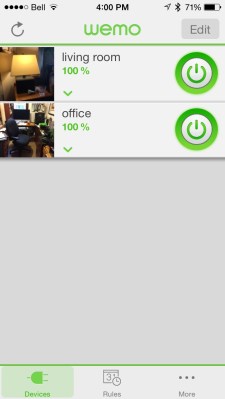Want smarter insights in your inbox? Sign up for our weekly newsletters to get only what matters to enterprise AI, data, and security leaders. Subscribe Now
Nowhere is the war for the smart home raging harder than on the lighting front.
Traditional players and new contenders with connected lighting products are duking it out to replace the humble lightbulb. The goal: to give consumers total control over their lighting, whether they’re at home or not.
Philips, a company that has had lighting tech baked into its DNA for decades, is arguably today’s front-runner with its Hue line of smart lights. But that doesn’t mean there isn’t room for others.
Belkin, a company best known for its diverse array of tech accessories, has recently made a play for the entire connected home, claiming everything from power outlets to slow cookers, with its WeMo wireless technology. Now it’s taking on lighting.
AI Scaling Hits Its Limits
Power caps, rising token costs, and inference delays are reshaping enterprise AI. Join our exclusive salon to discover how top teams are:
- Turning energy into a strategic advantage
- Architecting efficient inference for real throughput gains
- Unlocking competitive ROI with sustainable AI systems
Secure your spot to stay ahead: https://bit.ly/4mwGngO
Launched last month, Belkin’s WeMo Smart LED Bulbs are the latest products in the rapidly expanding connected lighting market.
They’re going up against LIFX, Philips Hue, TCP, and GE’s new line of Link products.
Hardware
Belkin’s design for the WeMo Smart LED Bulbs is so simple and so unobtrusive you could easily mistake them for the hundreds of CFL and LED standard 60-watt equivalents on the market. They are, well, boring looking. And that’s just fine. When you consider that standard lightbulbs — regardless of how smart they might be — usually end up hidden in a fixture, what they look like is largely irrelevant.
Unlike Philips’ Hue bulbs, which have some fairly significant weight to them, the Belkin WeMo bulbs are no heavier than an average CFL.
The other part of the WeMo setup is the WeMo Link, a Wi-Fi/ZigBee bridge or gateway, depending on your preferred terminology. The WeMo Link is self-contained and simply plugs into any standard wall outlet. It, too, is unremarkable, save for its size — the WeMo Link juts out about 1 ¾ inches from the wall, and its rounded-square shape might make it hard to ignore if you plug it into a highly visible wall plate.
That said, it manages to avoid a common mistake of many other wall-wart designs: crowding out the adjacent outlet. You’ll easily be able to plug something else above or below (or beside?) the WeMo Link.
The WeMo Link can be located anywhere in your home where you have reasonable Wi-Fi signal strength, much like the Wink HUB or the Revolv. This design has obvious placement advantages over the Philips Hue, which uses a gateway that requires power and a direct Ethernet connection to your router.
Light Quality
Perhaps the most important part of the WeMo bulb design is the designation it carries, printed on its white base: 800 Lumens.
This number is important for one simple reason: If your goal is to replace a conventional 60-watt incandescent bulb (or any other 60-watt equivalent) with a smart LED bulb, it has to have the same light output when operated at maximum intensity. A standard 60-watt incandescent produces 800 lumens — the same as the Belkin WeMo. A (color-capable) Philips Hue, by contrast, only produces 600 lumens.
The WeMo consumes a full watt more than the Hue (9.5W vs. 8.5W), but that seems to be the price you pay for a brighter light. Plus, the WeMo is limited to a 3,000K soft-white light, while the Hue can produce nearly every color of the rainbow. But when using the two bulbs for general-purpose lighting (which one assumes is the norm, rather than the exception) the WeMo provides a brighter — and therefore more flexible — light source. Note: The Philips Hue Lux produces 750 lumens, better than the Hue but still not as bright as the WeMo.
The 3,000K color temperature looks just a tad warmer to me than other LED bulbs that claim the same number, and that’s a good thing. I’ve always felt most incandescent replacements run a little too cold to be true substitutes.
Software and Setup
This is not what Belkin will want to hear, but I have to tell you: My first attempt to set up and configure the WeMo Smart LED bulbs was painful.
The procedure is very straightforward. 1. Plug in the WeMo Link within Wi-Fi range of your router. 2. Screw in the WeMo bulbs and turn their power source on (no dimmers). 3. Download the WeMo app for iOS or Android, and follow the instructions.
Everything went swimmingly until the app detected a new firmware update. Dutifully, I hit “update,” and that’s when the wheels fell off. Suddenly, the app couldn’t detect any of the bulbs, and no amount of restarting the app or resetting the WeMo Link (or the bulbs) helped. If anything, it got worse as I ended up in an endless loop of trying to get the WeMo Link to reestablish its connection with my router — something it was apparently unable to do.
The app’s built-in help option drives to a non-mobile friendly Web page that simply outlines your options for resetting the different hardware components. It further advises that if these steps don’t help, you should delete the app and start from scratch. I did. And it finally worked.
Firmware updates are a necessary evil in the world of smart devices, but when they cause such a profound disruption, something is wrong. The average consumer, I’m convinced, would never have had the patience to do what I did and would probably have sent the bulbs back to the retailer in frustration.
The good news, however, is that once you do get the WeMo bulbs configured, the app itself works well and is far easier to navigate and use than the awkward and confusing app that Philips saddles its Hue users with.
It’s easy to name your bulbs, control their brightness, set timers based on time of day or sunrise/sunset, and adjust how rapidly the bulbs turn on and off (from instantly to a gradual 30-minute cycle or anything in between). Bulbs can be grouped and ungrouped with the ability to have timers apply to groups as well as individual bulbs. All WeMo products are designed to work with the IFTTT Web automation service, but as of the writing of this review, IFTTT had not added the channel for the WeMo bulbs. We are told it will be available “soon.”
What’s conspicuously absent, especially when you compare the Belkin WeMo to the Philips Hue, is the ability to control lighting via geofencing. This is where your bulbs can turn themselves on or off when you leave (or arrive) within a set distance from home. Philips enables this once you create a free Hue account (presumably because the app must communicate with the Hue bulbs via the Hue cloud). But there is no such option with the WeMo.
Conversely, with WeMo, you can control your lights from anywhere without the need for a WeMo account, and what’s more, you can do it from within the app. Strangely, Philips Hue throws you to a Hue Web page when you want to control your lights over the Internet instead of your home Wi-Fi network.
Price
At $99 for a two-bulb starter pack, which includes the required WeMo Link, Belkin is on par with the Philips Hue Lux starter pack, which, given its lack of color-changing capability, is a more fair comparison than the regular Hue. Individual WeMo bulbs go for $29 — the same as individual Hue Lux bulbs.
Up until a few months ago, it would have been easy to see these prices as acceptable — even cheap when compared to the color-capable Hue or LIFX — but this is a hot market and changes are happening fast. Well-reviewed TCP offers a two-bulb starter kit for $70 to $80, while GE’s new Link bulbs come in a two-bulb starter pack with a Wink hub for just $50, and individual bulbs are only $15. Packing the same 800 lumen strength and an almost identical feature set, GE’s pricing makes it hard to ignore.
Bottom Line
If what you’re looking for is a way to add some custom lighting to your home, using the most energy-efficient technology on the market, the Belkin WeMo Smart LED Bulbs certainly fit the bill, especially if you only want to outfit a few light fixtures. The Belkin bulbs provide an easy (though not perfect) setup and simple operation, and they can be paired with other WeMo products to create a sophisticated smart home environment.
But even though the WeMo is directly competitive to the Philip Hue Lux in terms of price, both of these smart-lighting solutions carry an almost prohibitive price tag of $29/bulb. Our house has light fixtures with a total of 25 standard lightbulbs. To replace them all with WeMos or Hue Luxes would cost a staggering $725. Yes, we’d save some money on switching to LED, but at today’s energy prices it would take decades to break even, let alone save money.
Even at GE’s $15/bulb price point (still almost three times the cost of a non-smart LED bulb), the cost savings are dubious.
That said, if you’re -– ahem — smart about the number and placement of these smart bulbs, they can eliminate the need for external physical timers, give you remote control over key lights, and, through the use of IFTTT, provide a visual means of notification for events like the arrival of a new email, or being tagged in a photo on Facebook, or @ mentioned on Twitter. Because, well, now you can.









